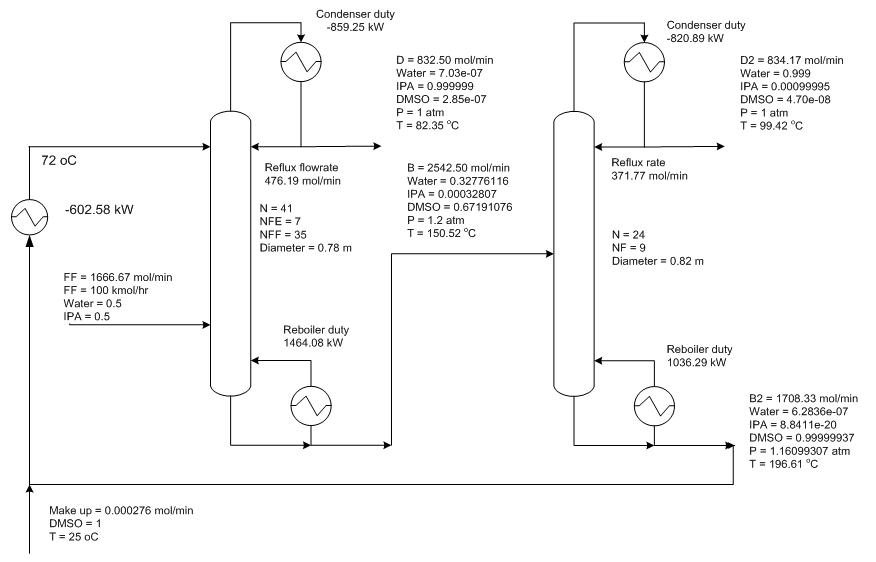302i Design and Control of Isopropyl Alcohol Dehydration Via Homogeneous Azeotropic Distillation Using Dimethyl Sulfoxide as Extractive Agent
IPA is widely used in semi-conductor industry as a cleaning agent, thus the recovery of IPA from waste solvent stream is an important issue worthy of detail study. This waste liquid stream contains mainly isopropyl alcohol and water. In this study, feed stream with equal molar of IPA and water was assumed. The conceptual design of the overall homogenous azeotropic distillation column system contains two columns and a recycle stream. The first column is the homogeneous azeotropic distillation column with two feed streams including the fresh feed stream and the stream to add extractive agent into this column. The top product of this column is pure IPA with the same ultra-high purity of 99.9999 (mol % IPA) as in Chien, et al. (2004) for re-use in the semi-conductor industry. The bottom product contains water and DMSO is sent to the recovery column. In this regular distillation column, these two components are separated with top water product at purity specification of 99.9% and bottom DMSO product recycle back to the first column, thus only a very small DMSO make-up stream is needed in the overall process.
There are quite a few design variables need to be optimized. They are: the feed ratio, total number of stages, and two feed stages of the homogeneous azeotropic column; and the total number of stages and the feed stage of the recovery column. Another design decision is to either keep the recycle stream at the same bottom temperature of the recovery column or an additional cooler is necessary at the recycle stream. Total annualized cost (TAC) will be used for the determination of the above design variables. The final optimized flowsheet is shown in Figure 1 below which including cooling of recycle stream. The TAC of this optimized flowsheet will be compared to the optimized flowsheet via heterogeneous azeotropic column system.
Because the feed composition of a waste IPA stream in semi-conductor industry can vary widely, thus the overall control strategy should be able to handle large feed composition disturbances. The operability range of this homogeneous azeotropic column system under proposed overall control strategy will be compared to that of the heterogeneous azeotropic column system while still keeping the products (IPA and water) purity at their specifications.
Literature Cited
Gmehling, J.; Mollmann, C. Synthesis of Distillation Process Using Thermodynamic Models and the Dortmund Data Bank. Ind. Eng. Chem. Res. 1998, 37, 8, 3112-3123.
Chien, I. L.; Zeng, K. L.; Chao, H. Y. Design and Control of a Complete Heterogeneous Azeotropic Distillation Column System. Ind. Eng. Chem. Res. 2004, 43, 9, 2160-2174.
Keywords: Isopropyl Alcohol Dehydration, Homogeneous Azeotropic Distillation, Optimal Design, Design and Control.
